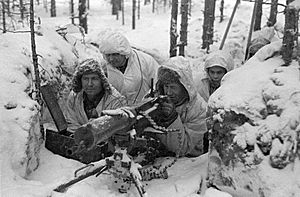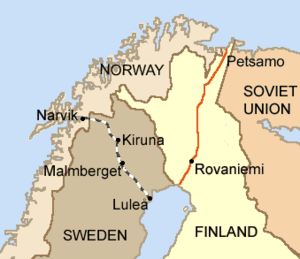Franco-British plans for intervention in the Winter War facts for kids
During the early part of World War II, the United Kingdom and France wanted to send soldiers to help Finland. Finland was fighting against the Soviet Union in a conflict called the Winter War, which began on November 30, 1939.
The plan was for British and French troops to travel through Norway and Sweden. Both Norway and Sweden were neutral countries. However, these countries said no to the plan. They were afraid that allowing troops to pass would drag them into the war. The Moscow Peace Treaty ended the Winter War in March 1940. This meant the help from Britain and France never happened.
Contents
Why Help Finland?
The Winter War began in November 1939. By February 1940, the Soviet army broke through Finland's strong defenses, called the Mannerheim Line. This made Finland's army very tired. The Finnish government had to consider making peace on the Soviet Union's terms.
When people in France and Britain heard that Finland might lose its freedom, they became very upset. They already supported Finland. Many wanted their countries to send military help. When news of a possible peace deal reached Paris and London, both governments decided to offer military support.
Finland's fight against the Soviet invasion happened during a quiet time in World War II. This period was known as the "Phony War" because there was little fighting on the main Western Front. So, everyone's attention turned to the Nordic countries. Leaders in London and Paris spent months planning. They had many disagreements and changed their minds often.
Secret Goals of the Allies
Britain and France finally agreed on a plan. It involved invading Norway, Sweden, Iceland, and the Faroe Islands. They did not ask for permission first. Their main goals were to hurt Germany's war economy and help Finland. They also thought about fighting the Soviet Union. The main naval base for this operation would be Scapa Flow in the Orkney Islands.
The Soviet invasion of Finland made many people angry. This anger was felt in Britain, France, and even the neutral United States. The League of Nations said the Soviet Union was the attacker. They even kicked the Soviet Union out of the League. Many American newspapers wrote daily headlines about the attack on Finland. This made people feel even worse about Russia.
The real goal for Britain and France was to stop Germany's war efforts. They wanted to cut off shipments of Swedish iron ore to Germany. This ore was very important for German factories making weapons. British officials believed stopping the ore would greatly harm German industry. It might even stop German industry completely. This would make the war much shorter. The idea was to move soldiers from the quiet Western Front to a new active front.
By December, British military leaders really liked this idea. They had realized their first plan, attacking German oil supplies, would not be approved. Winston Churchill, who was in charge of the navy, strongly pushed for invading Norway and Sweden. He wanted to help Finland and cut off Germany's iron supplies. French leaders also strongly supported the plan. They wanted their soldiers to be active. The Soviet army's poor performance against Finland made the Allies more confident. They thought an invasion and a war against the Soviets would be successful. However, Neville Chamberlain's government in London was hesitant. They put off the invasion plans. Also, neutral Norway and Sweden refused to cooperate.
First Plans for Help
The first plan was approved in early February 1940. It involved 100,000 British and 35,000 French soldiers. They would land at the Norwegian port of Narvik. From there, they would go through Sweden to help Finland. They would also secure their supply routes. The operation was planned for March 20. But there was a condition: Finland had to formally ask for help. This was to avoid Germany saying that the British and French were invading.
On March 2, Britain and France officially asked Norway and Sweden for permission to pass through their lands. The Allies hoped their help would bring Norway and Sweden to their side. However, Adolf Hitler had already told Sweden that if British and French troops entered Swedish land, Germany would invade immediately.
The original plan was to defend all of Scandinavia north of a line from Stockholm to Gothenburg or Oslo. This would have included Sweden's two largest cities. It also meant a large part of Sweden might become a war zone. The plan was later changed. It would only include the northern half of Sweden and the narrow coast of Norway next to it.
Norway and Sweden Say No
The Norwegian government said no to the British and French plan. They would not allow the troops to pass.
The Swedish government, led by Prime Minister Per Albin Hansson, also refused. Sweden had not declared itself neutral in the Winter War. However, Sweden had declared neutrality in the war between France, Britain, and Germany. The Swedish government argued that allowing British and French troops to pass would break international laws about neutrality.
Many believe this was an excuse. Sweden wanted to avoid making the Soviet and German governments angry. Another reason was that Sweden did not want the Allies to fight Germany on Swedish soil. This could destroy Swedish towns and roads.
The Swedish government also said no to Finland's repeated requests for Swedish soldiers to fight in Finland. Sweden also made it clear that it could not keep sending weapons and supplies for much longer. Finland was stuck. The Allies wanted the war to continue. But Sweden and Norway feared that the Allies and Germans might soon fight on their land. Norway and Sweden also worried about many Finnish refugees if Finland lost the war.
Fifteen months later, Sweden did allow German troops to pass through. One German division traveled across Sweden from occupied Norway to Finland. They were joining the German attack on the Soviet Union. Over the next three years, more than 2 million German soldiers and 100,000 German military trains crossed neutral Swedish land.
Final Offers and Peace
Germany and Sweden pressured Finland to accept peace, even if the terms were bad. Britain and France wanted the opposite. They gave Finland different plans and numbers of soldiers. France and Britain promised to send 20,000 men by the end of February.
By the end of February, Finland's military leader, Field Marshal Carl Gustaf Emil Mannerheim, felt the war was hopeless. On February 29, the Finnish government decided to start peace talks. On the same day, the Soviets attacked Viipuri.
When France and Britain realized Finland was thinking about peace, they made a new offer. They would send 50,000 troops if Finland asked for help before March 12. Finland hoped for Allied help, but its situation became worse and worse. Finland agreed to a peace deal on March 13. This meant they had lost.
On March 20, Paul Reynaud became prime minister of France. He was more aggressive and demanded an immediate invasion. Chamberlain and the British government finally agreed. They gave orders for Operation Wilfred, a plan to create a reason for invasion. However, Germany invaded first. Germany quickly conquered Denmark and southern Norway in Operation Weserübung. This stopped Allied efforts in Scandinavia.
Because Britain failed in Norway, it decided it needed naval and air bases in Iceland. Even though Iceland wanted to stay neutral, Britain felt it had to occupy Iceland for military reasons. The British occupied the Faroe Islands on April 13. They decided to occupy Iceland on May 6.
See also
- Operation Wilfred, a plan to place mines in neutral Norwegian waters.
- Allied campaign in Norway
- Foreign support in the Winter War
- Plan R 4, a plan to invade Northern Norway and Sweden.
- Swedish iron mining during World War II
- Operation Pike, a plan to bomb Soviet oil fields.



